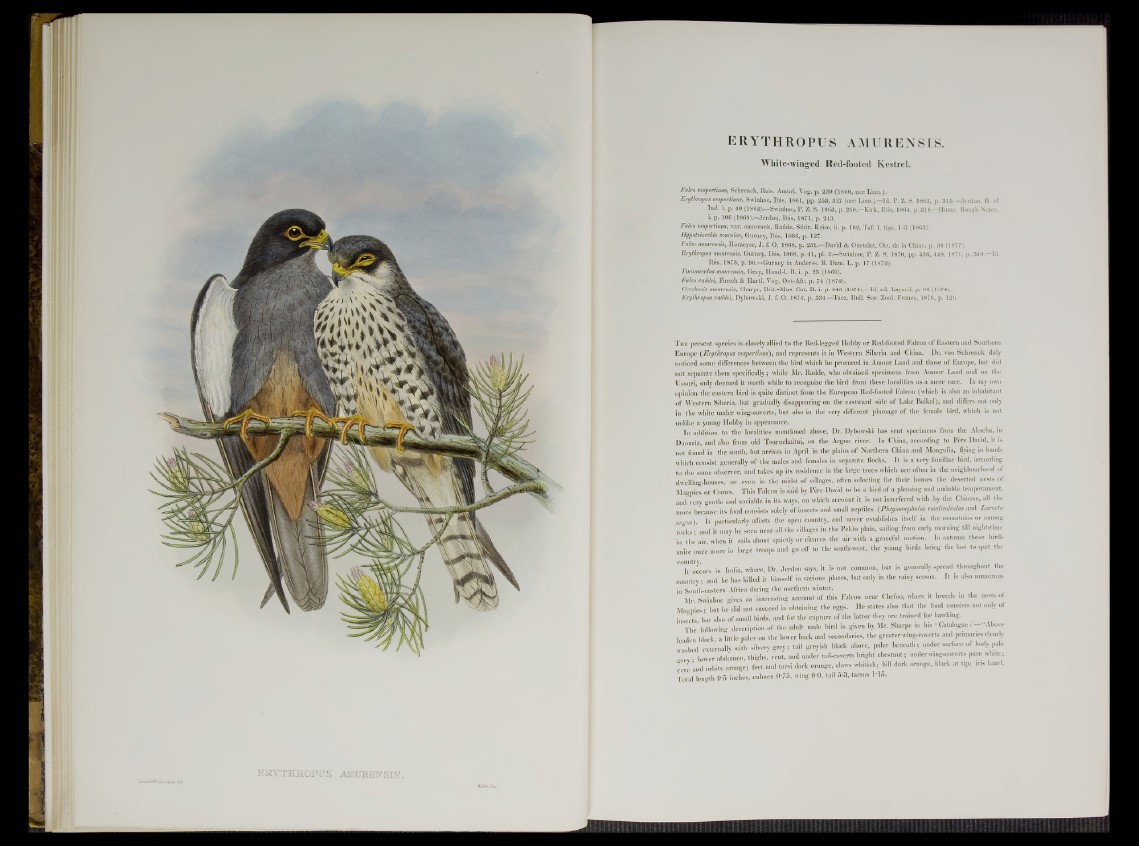
ERYTHROPUS AMUBENSIS.
ERYTHROPUS AMURENSIS.
White-wing-ed Red-footed Kestrel.
Falco vespertinus, Schrenck, Reis. Amurl. Vog. p. 230 (1860, nec Linn.).
Erythropus vespertinus, Swinhoe, Ibis, 1861, pp. 253, 327 (nec Linn.).—Id. P. Z. S. 1862, p. 315.—Jerdon, B. of
Ind. i. p. 40 (1862).—Swinhoe, P. Z. S. 1863, p. 260.—Kirk, Ibis, 1864, p. 316.—Hume, Rough Notes,
i. p. 106 (1869).—Jerdon, Ibis, 1871, p. 243.
Falco vespertinus, var. amurensis, Radde, Sibir. Reise, ii. p. 102, Taf. 1. figs. 1-3 (1863).
Hypotriorchis concolor, Gurney, Ibis, 1866, p. 127.
Falco amurensis, Homeyer, J. f. O. 1868, p. 251.—David & Oustalet, Ois. de la Chine, p. 34 (1877).
Erythropus amurensis, Gurney, Ibis, 1868, p .41, pi. 2.—Swinhoe, P. Z. S. 1870, p p .436, 448, 1871, p. 340—Id.
Ibis, 1873, p. 96.—Gurney in Anderss. B. Dam. L. p. 17 (1872).
Tinnunculus amurensis, Gray, Hand-1. B. i. p. 23 (1869).
Falco raddei, Finsch & Hartl. Vog. Ost-Afr. p. 74 (1870).
Cerchneis amurensis, Sharpe, Brit.-Mus. Cat. B. i. p. 445 (1874).—Id. ed. Layard, p. 66 (1874).
Erythropus raddei, Dybowski, J. f. O. 1874, p. 334.—Tacz. Bull. Soc. Zool. France, 1876, p. 126.
T h e present species is closely allied to the Red-legged Hobby or Red-footed Falcon of Eastern and Southern
Europe (Erythropus vespertinus'), and represents it in Western Siberia and China. Dr. von Schrenck duly
noticed some differences between the bird which he procured in Amoor Land and those of Europe, but did
not separate them specifically ; while Mr. Radde, who obtained specimens from Amoor Land and on the
Ussuri, only deemed it worth while to recognize the bird from these localities as a mere race. In my own
opinion the eastern bird is quite distinct from the European Red-footed Falcon (which is also an inhabitant
of Western Siberia, but gradually disappearing on the eastward side of Lake Baikal), and differs not only
in the white under wing-coverts, but also in the very different plumage of the female bird, which is not
unlike a young Hobby in appearance.
In addition to the localities mentioned above, Dr. Dybowski has sent specimens from the Akscha, in
Daouria, and also from old Tsuruchaitui, on the Argun river. In China, according to Père David, it is
not found in the south, but arrives in April in the plains of Northern China and Mongolia, flying in bands
which consist generally of the males and females in separate flocks. It is a very familiar bird, according
to the same observer, and takes up its residence in the large trees which are often in the neighbourhood of
dwelling-houses, or even in the midst of villages, often selecting for their homes the deserted nests of
Magpies or Crows. This Falcon is said by Père David to be a bird of a pleasing and amiable temperament,
and3very gentle and sociable in its ways, on which account it is not interfered with by the Chinese, all the
more because its food consists solely of insects and small reptiles (Phrtjnocephalus caudmohulus and Lacerta
arms). It particularly affects the open country, and never establishes itself in the mountains or among
rocks; and it may be seen near all the villages in the Pekin plain, sailing from early morning till night-time
in the air, when it sails about quietly or cleaves the air with a graceful motion. In autumn these birds
H I troops and go off to the south-west, the young birds unite once more in being the last to quit the
country.
It occur India where, Dr. Jerdon says, it is not common, but is generally spread throughout the
country; and he has'killed it himself in various places, hut only in the rainy season. It is also numerous
in South-eastern Africa during the northern winter. . . .
Mr Swinhoe gives an interesting account of this Falcon near Chefoo. where .t breeds in the nests of
Magpies ■ but he did not succeed in obtaining the eggs. He states also that the food consists not only of
insects but also of small birds, and for the capture of the latter they are trained for hawking.
The' following description of the adult male bird is given by Mr. Sharpe in h.s ■ Catalogue : - “Above
leaden black a little paler on the lower back and secondaries, the greater wing-coverte and primaries clearly
washed externally with silvery grey; tail greyish black above, paler beneath ; under surface of body pale
. M | abdomen, thighs, vent, and under tail-coverts bright chestnut; under wing-coverts pure white;
cere’and orbits orange; feet and tarsi dark orange, claws whitish; bill dark orange, black at tip; iris hazel.
Total length 9 5 inches, culmen 0 7 5 , wing 9-0, tail 5 3, tarsus M5.